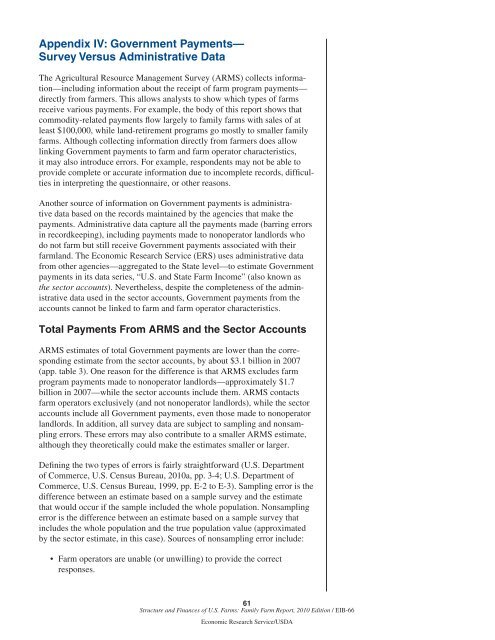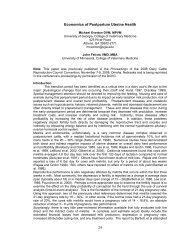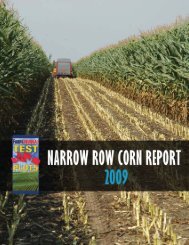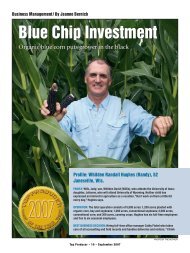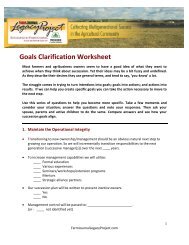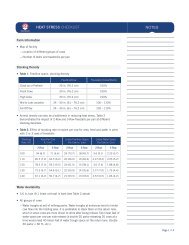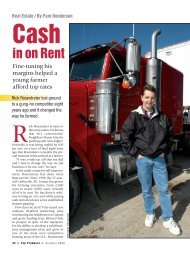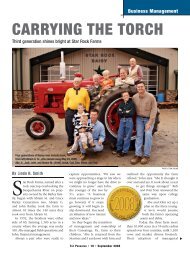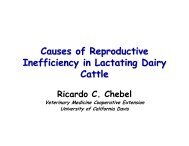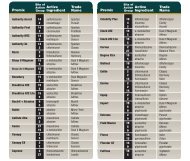Structure and Finances of U.S. Farms: Family Farm Report ... - AgWeb
Structure and Finances of U.S. Farms: Family Farm Report ... - AgWeb
Structure and Finances of U.S. Farms: Family Farm Report ... - AgWeb
You also want an ePaper? Increase the reach of your titles
YUMPU automatically turns print PDFs into web optimized ePapers that Google loves.
Appendix IV: Government Payments—Survey Versus Administrative DataThe Agricultural Resource Management Survey (ARMS) collects information—includinginformation about the receipt <strong>of</strong> farm program payments—directly from farmers. This allows analysts to show which types <strong>of</strong> farmsreceive various payments. For example, the body <strong>of</strong> this report shows thatcommodity-related payments flow largely to family farms with sales <strong>of</strong> atleast $100,000, while l<strong>and</strong>-retirement programs go mostly to smaller familyfarms. Although collecting information directly from farmers does allowlinking Government payments to farm <strong>and</strong> farm operator characteristics,it may also introduce errors. For example, respondents may not be able toprovide complete or accurate information due to incomplete records, difficultiesin interpreting the questionnaire, or other reasons.Another source <strong>of</strong> information on Government payments is administrativedata based on the records maintained by the agencies that make thepayments. Administrative data capture all the payments made (barring errorsin recordkeeping), including payments made to nonoperator l<strong>and</strong>lords whodo not farm but still receive Government payments associated with theirfarml<strong>and</strong>. The Economic Research Service (ERS) uses administrative datafrom other agencies—aggregated to the State level—to estimate Governmentpayments in its data series, “U.S. <strong>and</strong> State <strong>Farm</strong> Income” (also known asthe sector accounts). Nevertheless, despite the completeness <strong>of</strong> the administrativedata used in the sector accounts, Government payments from theaccounts cannot be linked to farm <strong>and</strong> farm operator characteristics.Total Payments From ARMS <strong>and</strong> the Sector AccountsARMS estimates <strong>of</strong> total Government payments are lower than the correspondingestimate from the sector accounts, by about $3.1 billion in 2007(app. table 3). One reason for the difference is that ARMS excludes farmprogram payments made to nonoperator l<strong>and</strong>lords—approximately $1.7billion in 2007—while the sector accounts include them. ARMS contactsfarm operators exclusively (<strong>and</strong> not nonoperator l<strong>and</strong>lords), while the sectoraccounts include all Government payments, even those made to nonoperatorl<strong>and</strong>lords. In addition, all survey data are subject to sampling <strong>and</strong> nonsamplingerrors. These errors may also contribute to a smaller ARMS estimate,although they theoretically could make the estimates smaller or larger.Defining the two types <strong>of</strong> errors is fairly straightforward (U.S. Department<strong>of</strong> Commerce, U.S. Census Bureau, 2010a, pp. 3-4; U.S. Department <strong>of</strong>Commerce, U.S. Census Bureau, 1999, pp. E-2 to E-3). Sampling error is thedifference between an estimate based on a sample survey <strong>and</strong> the estimatethat would occur if the sample included the whole population. Nonsamplingerror is the difference between an estimate based on a sample survey thatincludes the whole population <strong>and</strong> the true population value (approximatedby the sector estimate, in this case). Sources <strong>of</strong> nonsampling error include:• <strong>Farm</strong> operators are unable (or unwilling) to provide the correctresponses.61<strong>Structure</strong> <strong>and</strong> <strong>Finances</strong> <strong>of</strong> U.S. <strong><strong>Farm</strong>s</strong>: <strong>Family</strong> <strong>Farm</strong> <strong>Report</strong>, 2010 Edition / EIB-66Economic Research Service/USDA


